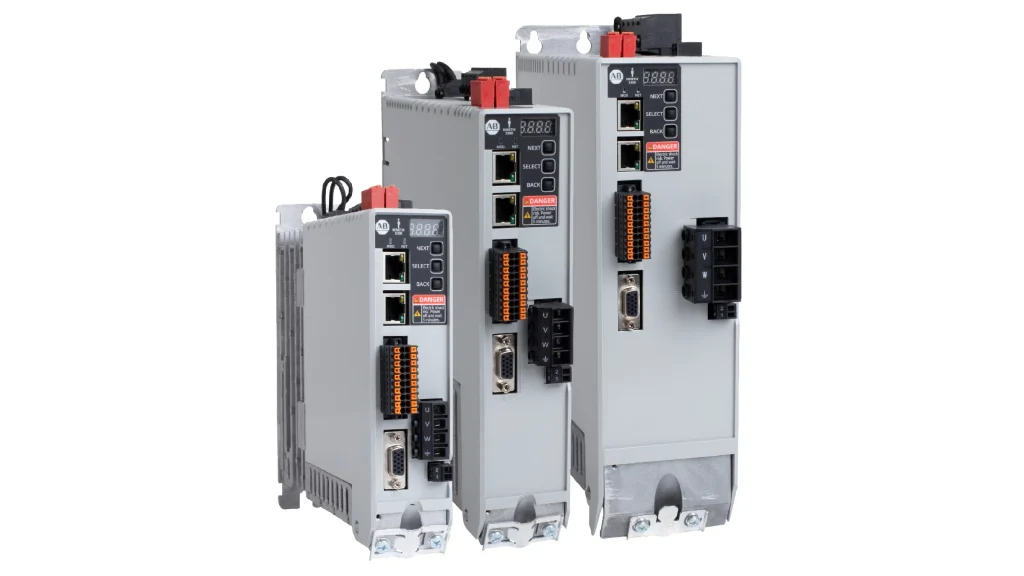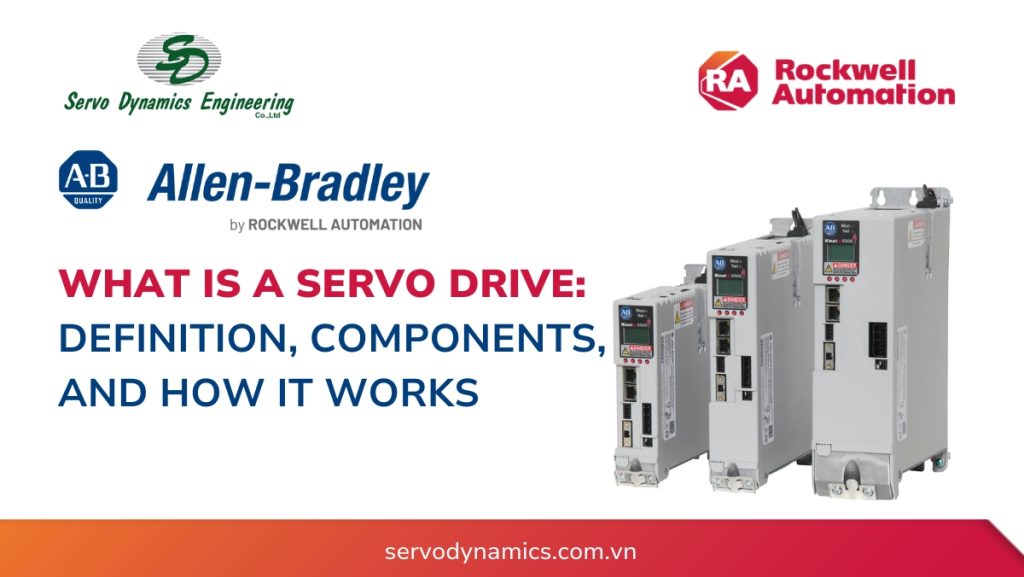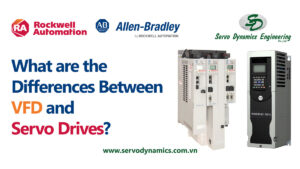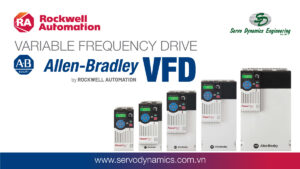Consulting, Industrial Automation, Solutions
What is a Servo Drive and How it works
Servo drives play a crucial role in precise control and enhancing motion performance. They are widely used in smart factories, CNC machines, and robotic systems. So how do they work and why are they important? Let’s explore in the article below:
What is a Servo Drive?

Servo Drive, also known as a servo controller, is an electronic device that acts as an intermediary between the main controller (PLC, CNC, etc.) and the servo motor. Its primary function is to receive control signals from the controller, then amplify and adjust current, voltage, frequency, etc., to drive the servo motor to operate according to the required position, speed, and torque.
Simply put, the Servo Drive is both the “brain” and the “power amplifier” for the servo motor, ensuring the motor operates accurately and efficiently.
Components of a Servo Drive
A typical Servo Drive includes the following main components:
- Rectifier: Converts AC power to DC.
- DC Link: Stabilizes voltage and filters out electrical noise.
- Inverter: Converts DC to variable-frequency AC to control the motor.
- Control Circuit: Analyzes signals, performs calculations, and controls output current accordingly.
- Feedback Interface: Receives data from the encoder to correct position/speed errors.
- Communication Port: Connects with PLC, HMI via protocols such as EtherNet/IP, Modbus, CANopen, etc.
- Protection Circuit: Provides protection against overvoltage, overcurrent, overheating, and short circuits.
How Does a Servo Drive Work?
Servo drives operate based on a closed-loop control principle, consisting of the following key steps:
Receiving Control Signals: The central control system (PLC, CNC, etc.) sends commands to the servo drive. These signals usually specify a desired position, speed, or torque.
Signal Processing and Amplification: The servo drive receives the low-power control signals and processes them. It then amplifies these signals into a power source with sufficient voltage and current to drive the servo motor.
Monitoring Feedback from the Motor: Servo motors are typically equipped with feedback devices like encoders or resolvers, which continuously capture real-time data such as position, velocity, or torque.
Comparison and Correction (Closed Loop): Feedback data from the motor is sent back to the servo drive. The drive compares the actual values with the target values. If any discrepancy is detected, the servo drive automatically adjusts the output voltage and current to correct the error. This process happens rapidly and continuously, ensuring high precision.
Power Supply to the Motor: The servo drive uses an external power source to energize and regulate the motor’s operation.
Motion Control: Based on input commands and feedback data, the servo drive controls the current flowing through the motor windings, thereby precisely controlling speed, torque, and position.
Applications of Servo Drives
Servo drives are widely used in areas requiring precise motion control, including:
- Industrial Robots: Control of robotic arms and joints.
- CNC Machines: Ensure accurate movement and positioning during metal, wood, or plastic machining.
- Packing Machines: Coordinate processes like feeding materials, cutting, sealing, gluing, etc.
- Automation Systems: Synchronize movements across production lines.
- Aerospace: Control aerodynamic surfaces, landing gear, and satellite positioning.
- Medical Equipment: Enable smooth and precise movement in modern medical devices.
- Antenna Positioning Systems: Precisely control direction and angle for satellite dishes, telescopes, etc.
Difference Between Servo Drives and VFDs
Variable Frequency Drives (VFDs) and servo drives are both essential motor control devices in automation. However, they have different structures and serve different purposes. Understanding these differences helps you choose the optimal solution for your business:
What is a VFD?
A Variable Frequency Drive (VFD), also known as an adjustable-frequency drive, is a device that controls the speed of an AC motor by varying the frequency and voltage of the power supplied to it. VFDs are commonly used in applications that do not require high precision, such as:
- Water pumps
- Ventilation fans
- Conveyors
- Air compressors
What is a Servo Drive?
A servo system is a motor control system capable of precisely regulating position, speed, and torque. Servo systems use feedback from sensors (typically encoders) to continuously and accurately adjust motor performance. They are applied in fields that demand high precision and rapid response, such as:
- CNC machines
- Industrial robots
- 3D printers
- Automated assembly lines
Comparison Between Variable Frequency Drives (VFD) and Servo Drives
| Criteria | Variable Frequency Drive (VFD) | Servo Drive |
|---|---|---|
| Control Mode | Open-loop or basic closed-loop | Closed-loop with continuous feedback |
| Accuracy | Moderate | Very high (±1µm) |
| Feedback | None or simple feedback | Feedback from encoder |
| Applications | AC motor speed control | Precise control of position, speed, and torque |
| Investment Cost | Lower | Higher |
| Control Capability | One VFD can control multiple motors | Each servo drive controls one motor |
Common Servo Drive Errors and How to Fix Them
During operation, Servo Drives can encounter several common errors:
- Overcurrent Error: Occurs when the current exceeds allowable limits, potentially caused by short circuits, overload, or motor faults.
Solution: Check wiring, motor condition, reduce the load, or replace the servo drive if necessary.
- Overvoltage Error: The input voltage or DC bus voltage exceeds permissible limits.
Solution: Check the power supply and ensure the voltage remains within the allowed range.
- Undervoltage Error: The input voltage is too low.
Solution: Inspect the power source and ensure it meets the required voltage specifications.
- Overtemperature Error: The servo drive becomes too hot due to poor working conditions, faulty cooling fans, or overload.
Solution: Check ambient conditions, ensure cooling fans are functioning, reduce the load, or allow the drive to cool down.
- Encoder/Resolver Error: Issues related to feedback signals from the motor’s encoder or resolver.
Solution: Check connections, verify feedback signals, or replace the encoder/resolver.
- Communication Error: Errors in data transmission between the servo drive and the controller.
Solution: Inspect communication cables and ensure the configuration between the servo drive and controller is correct.
- Position Error: A significant deviation between actual and commanded position.
Solution: Check parameter settings, control gains, load, or mechanical actuators.
- Hardware Error: Internal component failure within the servo drive.
Solution: Contact the supplier for repair or replacement support.
Allen-Bradley Servo Drives
Rockwell Automation offers a wide range of Allen-Bradley servo drive products, designed to meet diverse motion control needs in industrial applications. These drives integrate seamlessly with Rockwell’s automation ecosystem—including PLCs, programming software, and industrial networking solutions—simplifying the design, implementation, and operation of your automation systems.
Explore Allen-Bradley Servo Drive Product Lines
Servo Dynamics – Rockwell Automation Distributor in Vietnam
Servo Dynamics is the official distributor of Rockwell Automation in Vietnam. We provide genuine Allen-Bradley servo drives, ensuring optimal performance and quality for your motion control systems. With professional technical support and dedicated service, Servo Dynamics is your trusted partner for accessing advanced servo drive solutions from Rockwell Automation.

 Tiếng Việt
Tiếng Việt













